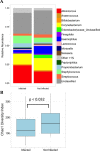Characterization of the nasopharyngeal microbiota in health and during rhinovirus challenge
- PMID: 25028608
- PMCID: PMC4098959
- DOI: 10.1186/2049-2618-2-22
Characterization of the nasopharyngeal microbiota in health and during rhinovirus challenge
Abstract
Background: The bacterial communities of the nasopharynx play an important role in upper respiratory tract infections (URTIs). Our study represents the first survey of the nasopharynx during a known, controlled viral challenge. We aimed to gain a better understanding of the composition and dynamics of the nasopharyngeal microbiome during viral infection.
Methods: Rhinovirus illnesses were induced by self-inoculation using the finger to nose or eye natural transmission route in ten otherwise healthy young adults. Nasal lavage fluid samples (NLF) samples were collected at specific time points before, during, and following experimental rhinovirus inoculation. Bacterial DNA from each sample (N = 97 from 10 subjects) was subjected to 16S rRNA sequencing by amplifying the V1-V2 hypervariable region followed by sequencing using the 454-FLX platform.
Results: This survey of the nasopharyngeal microbiota revealed a highly complex microbial ecosystem. Taxonomic composition varied widely between subjects and between time points of the same subject. We also observed significantly higher diversity in not infected individuals compared to infected individuals. Two genera - Neisseria and Propionibacterium - differed significantly between infected and not infected individuals. Certain phyla, including Firmicutes, Actinobacteria, and Proteobacteria, were detected in all samples.
Conclusions: Our results reveal the complex and diverse nature of the nasopharyngeal microbiota in both healthy and viral-challenged adults. Although some phyla were common to all samples, differences in levels of diversity and selected phyla were detected between infected and uninfected participants. Deeper, species-level metagenomic sequencing in a larger sample is warranted.
Keywords: Microbiota; longitudinal; nasopharynx; rhinovirus illness; sequencing.
Figures







References
-
- Chi DH, Hendley JO, French P, Arango P, Hayden FG, Winther B. Nasopharyngeal reservoir of bacterial otitis media and sinusitis pathogens in adults during wellness and viral respiratory illness. Am J Rhinol. 2003;17:209–214. - PubMed
-
- Hendley JO, Hayden FG, Winther B. Weekly point prevalence of Streptococcus pneumoniae, Hemophilus influenzae and Moraxella catarrhalis in the upper airways of normal young children: effect of respiratory illness and season. APMIS. 2005;113:213–220. - PubMed
-
- Puhakka T, Mäkelä MJ, Malmström K, Uhari M, Savolainen J, Terho EO, Pulkkinen M, Ruuskanen O. The common cold: effects of intranasal fluticasone propionate treatment. J Allergy Clin Immunol. 1998;101:726–731. - PubMed
LinkOut - more resources
Full Text Sources
Other Literature Sources

